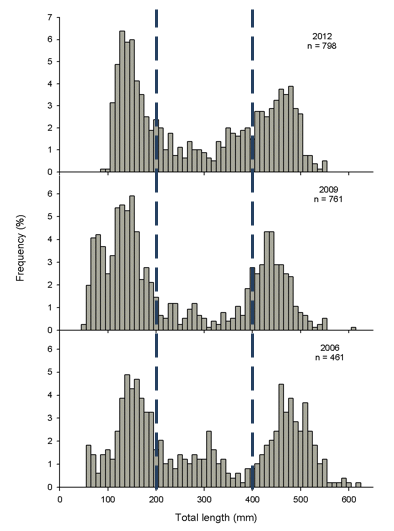The 2012 South Fork Boise River fishery population sampling by Idaho Fish and Game shows a continuing population size structure that has lots of small fish and large fish making up the raw sample, but few middle sized fish. And the numbers of medium sized fish are too small to explain the numbers of the larger fish. Below is the graph showing the 2012 population distribution by size in 2012 compared with 2009 and 2006:
Fish between 200 and 400 millimeters – roughly eight to sixteen inches in length, are too few to account for the percentage of the population in the 450+ mm size classes. This seemed especially a problem with the 2006 and 2009 samples as illustrated in the chart. The 2012 data shows an improvement in the larger end of that size gap.
If you are interested in seeing historic charts back to 1997 you can check out this past blog post.
The question remains: where are the middle-sized fish that fill the gap so there are the larger fish that we catch? Some indications are the middle-sized fish are probably rearing in the canyon section of the South Fork as seen in this comparison graph:
Then they move up and fill the habitat in the reach between Anderson Dam and Danskin Bridge. It’s not a perfect fit, but the size distribution does help explain some of the gap.
The idea for the title of this post comes from the book The Big Sort published in 2009 and presenting demographic information about how how “Americans have been sorting themselves into extremely homogeneous communities-not just by region and state, but by city and town. Over the past three decades, we have been choosing the neighborhoods, news shows, and places of worship that most closely reflect our individual values.” OK, so it’s not a perfect fit, but the age/size segregation is an important consideration in helping understand why the South Fork Boise River fishery exhibits an unconventional size class distribution.









2 Responses to Fishery Population Status II: The Big Sort Continues